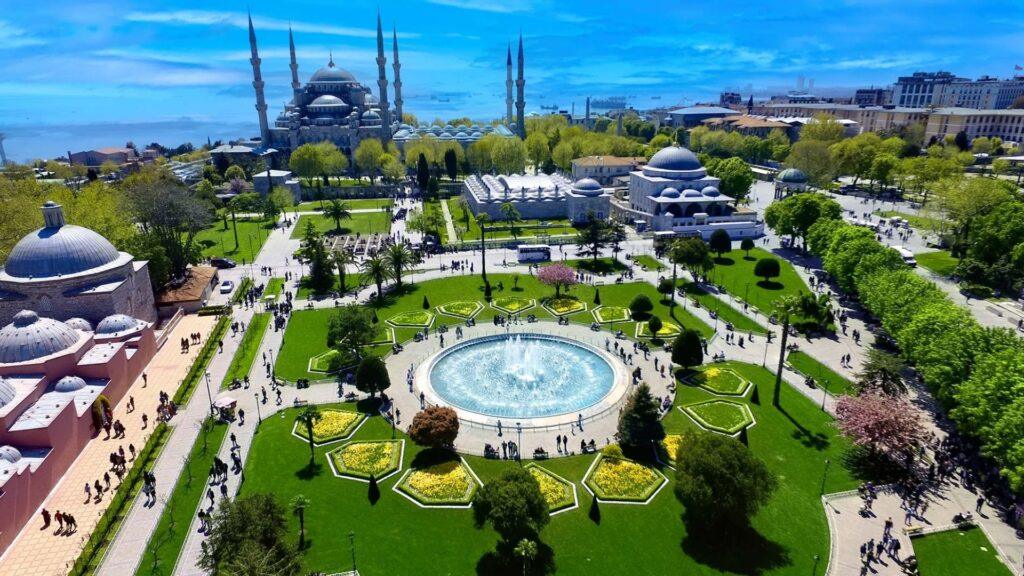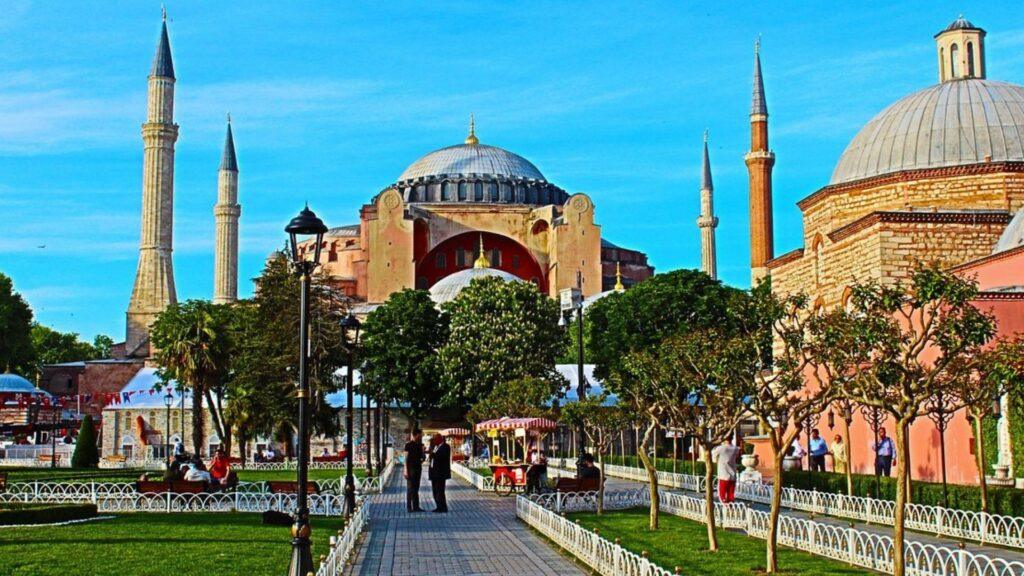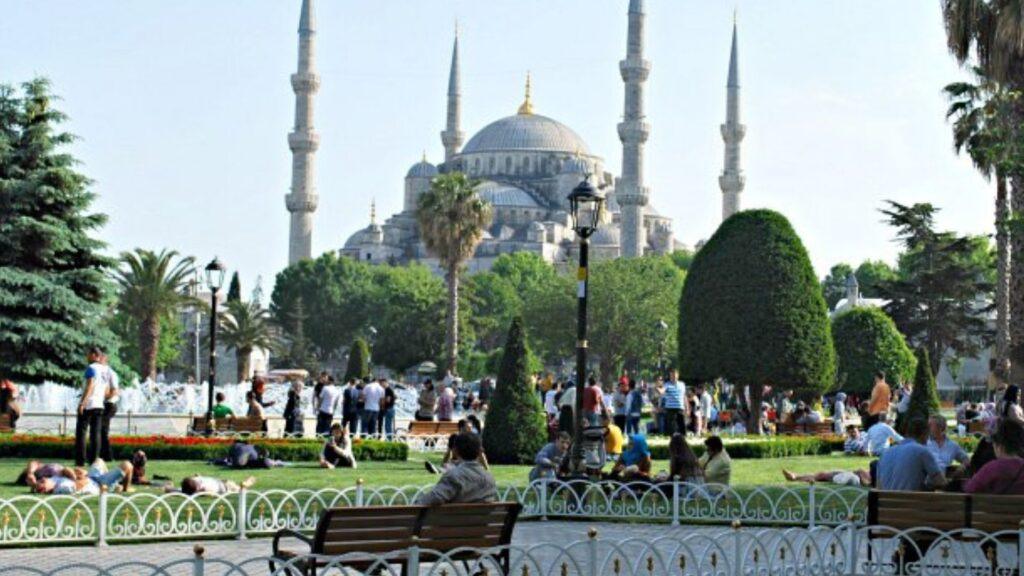
Sultanahmet Square: The Historic Heartbeat of Istanbul
Standing in the center of Sultanahmet Square is like standing at the crossroads of two empires. The very air seems to vibrate with the echoes of Roman chariot races, the whispers of Byzantine court intrigues, and the grandiose proclamations of Ottoman sultans. This is not just a tourist destination; it is the beating heart of Istanbul’s Historic Peninsula, a vast open-air museum where millennia of history are etched into every stone and monument. For those who wish to understand Istanbul, the journey begins and ends here, in the magnificent shadow of two of the world’s most imposing structures: Hagia Sophia and the Blue Mosque.
This guide will immerse you in the historical and cultural significance of Sultanahmet Square. We will discover its origins as a Roman sports stadium, trace its transformation into an Ottoman imperial center, and explore the iconic monuments that define its skyline. Prepare for a journey through time as we discover why this square is, and always has been, the undisputed soul of Istanbul.
A Journey Through Time: The Origins of Sultanahmet Square
The story of Sultanahmet Square is a story of transformation. Its foundations are much older than the Ottoman mosques that dominate it today. To understand its importance, we must first travel back to a time when Istanbul was Constantinople, the capital of the Byzantine Empire.
From Byzantium’s Hippodrome to an Ottoman Center
Long before it was known as Sultanahmet Square, this area was the legendary Hippodrome of Constantinople. Built by the Roman Emperor Septimius Severus in 203 AD and later enlarged by Constantine the Great, the Hippodrome was the epicentre of the city’s social and sporting life.
- A Stage for Spectacle: This U-shaped stadium was colossal, estimated to hold up to 100,000 spectators. The main events were the thrilling and often violent chariot races between two main factions, the Blues (Venetoi) and the Greens (Prasinoi). These weren’t just sporting teams; they represented political, social, and religious divisions within the city.
- The Spina: The central barrier of the Hippodrome, known as the spina, was adorned with magnificent monuments brought from all corners of the empire to showcase its power and wealth. Remarkably, some of these ancient treasures still stand in Sultanahmet Square today.
- More Than Just Games: The Hippodrome was also a political stage. Emperors were crowned here, military victories were celebrated with triumphant parades, and public executions were carried out. It was here, during the infamous Nika Riots of 532 AD, that tens of thousands were killed, nearly costing Emperor Justinian I his throne.
When the Ottoman sultan Mehmed the Conqueror took Constantinople in 1453, the Hippodrome was already in ruins, having been looted during the Fourth Crusade in 1204. However, the Ottomans recognized the historical and strategic importance of the area. They did not rebuild the stadium, but instead repurposed the large space, which they called At Meydanı (Horse Square), preserving it as the nerve center of imperial life.
The Architectural Jewels of Sultanahmet Square
Today, Sultanahmet Square is defined by the monumental structures that frame it. Each building and monument tells a unique chapter of Istanbul’s layered history, creating a skyline that is recognized across the globe.
The Blue Mosque (Sultan Ahmed Mosque): A Symphony in Blue
Directly facing Hagia Sophia is the majestic Sultan Ahmed Mosque, popularly known as the Blue Mosque. Commissioned by the young Sultan Ahmed I and completed in 1616, its purpose was to reassert Ottoman power and create a monument that could rival the grandeur of the Hagia Sophia.
- Architectural Marvel: Designed by Sedefkâr Mehmed Ağa, the mosque is a masterpiece of classical Ottoman architecture. Its most distinctive features are its six slender minarets, a unique design that caused controversy at the time as only the Grand Mosque in Mecca had six.
- The Iznik Tiles: The mosque earns its nickname from the more than 20,000 handmade blue Iznik ceramic tiles that adorn its interior walls. These tiles, featuring intricate floral and geometric patterns, create a breathtaking visual effect, bathing the interior in a cool, ethereal blue light.
- A Place of Worship: As a functioning mosque, it offers visitors a glimpse into the spiritual heart of the city. Remember to dress modestly (covering shoulders and knees) and women should cover their hair before entering.
Hagia Sophia: A Dome That Changed History
The undisputed queen of Sultanahmet Square is the Hagia Sophia (Ayasofya). Its history is a powerful symbol of Istanbul’s own complex identity.
- Byzantine Cathedral: Consecrated in 537 AD under Emperor Justinian I, it was the largest Christian church in the world for nearly a thousand years. Its massive dome was a revolutionary architectural achievement that was said to have “changed the history of architecture.”
- Ottoman Mosque: After the 1453 conquest, Sultan Mehmed II converted Hagia Sophia into an imperial mosque. Minarets were added to its exterior, and its Christian mosaics were covered with plaster.
- Secular Museum: In 1935, Mustafa Kemal Atatürk, the founder of the modern Turkish Republic, transformed it into a museum, a symbol of a new, secular Turkey.
- Reverted to a Mosque: In 2020, it was reconverted into a functioning mosque, a decision that remains a topic of international discussion.
Visiting Hagia Sophia is a profound experience, where you can see the seamless, and sometimes jarring, blend of Christian iconography and Islamic calligraphy under one magnificent dome.
The Silent Witnesses: Monuments of the Hippodrome
Walking through the central park of Sultanahmet Square, you are walking along the ancient spina of the Hippodrome. Three ancient monuments have survived the ravages of time:
- The Obelisk of Theodosius: This is the oldest monument in Istanbul. Carved in Egypt around 1500 BC, this pink granite obelisk was brought from the Temple of Karnak in Luxor to Constantinople by Emperor Theodosius I in 390 AD. The marble base features intricate carvings depicting the emperor and his family watching the chariot races.
- The Serpent Column: Forged from the melted-down shields of defeated Persian soldiers after the Battle of Plataea in 479 BC, this bronze column was a gift to the Temple of Apollo at Delphi. It originally depicted three intertwined serpents whose heads supported a golden bowl. The column was moved here by Constantine the Great. The heads were lost over the centuries, though one is on display in the nearby Istanbul Archaeology Museums.
- The German Fountain: The newest addition to the square, this ornate, octagonal fountain was a gift from German Emperor Kaiser Wilhelm II to Sultan Abdülhamid II in 1898 to commemorate the Emperor’s visit. Its beautiful neo-Byzantine style and golden mosaics stand in contrast to the more ancient monuments.
Explore our city tour service, which also includes Sultanahmet Square.
The Enduring Importance of Sultanahmet Square for Istanbul
The significance of Sultanahmet Square extends far beyond its historical monuments. It remains a vital part of Istanbul’s cultural, social, and economic fabric.
A Cultural and Social Epicenter
The square is a constant hive of activity. It is a meeting place for locals, a starting point for tourists, and a venue for national celebrations. During the holy month of Ramadan, the area comes alive at night, with families gathering to break their fast (iftar) in the park between the two large mosques. The vibrant atmosphere, filled with food stalls and festivities, highlights the square’s role as a community gathering place.
A UNESCO World Heritage Site
In 1985, the “Historic Areas of Istanbul,” with Sultanahmet Square at its core, was inscribed on the UNESCO World Heritage list. This designation recognizes the area’s outstanding universal value and highlights the importance of preserving its unique collection of monuments that have influenced architecture, arts, and urban planning for centuries. This status cements its position as one of the most significant historical sites on the planet.
An Economic Engine for Tourism
Sultanahmet Square is the undisputed centerpiece of Istanbul’s tourism industry. Its high concentration of world-class attractions, such as the Blue Mosque, Hagia Sophia, Topkapi Palace, and the Basilica Cistern, draws millions of visitors each year. The surrounding neighborhood is packed with hotels, restaurants, and shops, all thriving thanks to the activity generated by this historic center. It is an economic engine that supports thousands of jobs and showcases the wonders of Turkish culture and history to the world.
Planning Your Visit to Sultanahmet Square: Practical Tips
To make the most of your visit to this incredible area, here are a few practical tips:
- Best Time to Visit: The best times are during the spring (April-May) and autumn (September-October) when the weather is pleasant. To avoid large crowds, try to visit early in the morning on a weekday.
- Getting There: The most convenient way to reach Sultanahmet Square is by taking the T1 tram line to the “Sultanahmet” stop. It drops you right in the heart of the action.
- Dress Code: When visiting the Blue Mosque or Hagia Sophia, ensure your attire is respectful. Both men and women should have their knees and shoulders covered. Women will also need a headscarf (scarves are usually available to borrow at the entrance).
- Allocate Enough Time: You can see the main square in an hour, but to truly appreciate the Blue Mosque, Hagia Sophia, and nearby sites like the Basilica Cistern, you should plan for at least a full day.
Frequently Asked Questions (FAQ) about Sultanahmet Square
Q: Is there an entrance fee for Sultanahmet Square? : No, the square itself is a public park and is free to enter and walk around 24/7. However, individual attractions like Hagia Sophia, Topkapi Palace, and the Basilica Cistern have their own entrance fees. Entrance to the Blue Mosque is free, but donations are welcome.
Q: What is the difference between Sultanahmet and the Blue Mosque? : “Sultanahmet” refers to the entire square and the surrounding neighborhood. The “Blue Mosque” is the popular name for the Sultan Ahmed Mosque (Sultanahmet Camii), which is the most prominent landmark on the square.
Q: How much time do I need for Sultanahmet? : A minimum of one full day is recommended to see the main sights without rushing. This allows you to visit Hagia Sophia, the Blue Mosque, the Hippodrome monuments, and the Basilica Cistern. If you want to include Topkapi Palace, plan for a day and a half to two days.
Conclusion: Sultanahmet Square – Where History is Always Present
Sultanahmet Square is more than just a place on the map; it is a testament to the resilience and greatness of human civilization. Here, the legacies of the Roman, Byzantine, and Ottoman empires do not lie buried, but stand proudly in the open air, inspiring awe and admiration. To walk on its stones is to follow in the footsteps of emperors, sultans, and countless generations who have lived, celebrated, and mourned in this very place. It is the grand stage of Istanbul’s history, a place where the past is not only remembered but powerfully and perpetually present.

